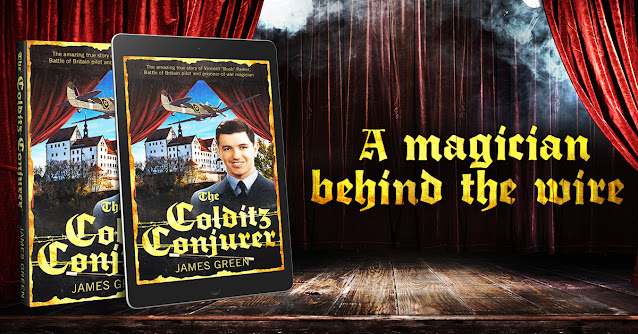"A magician is an actor playing the part of a magician"
Famed Nineteenth Century magician and illusionist, Jean-Eugene Robert-Houdin, once wrote, "a magician is an actor playing the part of a magician".
During wartime, movies provided war-weary audiences an escape from the turbulence and sacrifice of war, while also providing an opportunity for nations to boost morale, through government-funded propaganda films.
Some World War Two-era magicians were also actors, appearing in movies made between 1939-1945 to entertain the public.
The most famous of these was James Stewart. Before becoming a world-famous movie star, Stewart started out as an amateur magician, partnering with fellow magician Bill Neff. He was a member of the International Brotherhood of Magicians and contributed several tricks to magic magazines. Turning to acting, Stewart appeared in more than 90 films, television programmes, and shorts. He starred in 12 films between 1939-1941, including Mr. Smith Goes to Washington (1939), It's a Wonderful Life (1939), and The Philadelphia Story (1940), for which he earned an Academy Award for Best Actor. When America joined World War Two in late 1941, Stewart became the first major American movie star to enlist in the U.S. Army. He become a bomber pilot, was awarded the Distinguished Flying Cross and achieved the rank of full Colonel. After the war, he resumed his acting career but carried on serving his country in the U.S. Air Force Reserve, only fully retiring from military service at the age of 60.
Magician John Calvert broke into films making $600 a day as a hand-double for Clark Gable in Honky Tonk (1941). Scenes required Gable's hands to do some clever, tricky manoeuvring, which Gable couldn't pull off, so Calvert was brought in. He then appeared in Bombardier (1943, playing Calvert the Magician), Ali Baba and the Forty Thieves (1944), Are These Our Parents? (1944, playing The Great Gaspar - Magician), The Mark of the Whistler (1944), Youth on Trial (1945), The Return of the Durango Kid (1945), Ten Cents a Dance (1945) and Lawless Empire (1945). Other film appearances followed after the war. At the same time, Calvert continued working as a magician, with his own magic show running for five months in a Hollywood theatre during the war.
Another magician-turned-actor, was Fred Keating. An American, Keating appeared in over a dozen Hollywood movies in the 1930s. During the war years, he had roles in the magic-themed Eternally Yours (1939), Society Smugglers (1939), and the musical film Tin Pan Alley (1940).
Other magician-actors included Orson Welles. Considered one of the greatest filmmakers of all time, Welles was an accomplished director, writer, and producer. By the outbreak of war, Welles had established himself in theatre and radio, and was only just breaking into the film industry. His directorial debut film (which he also co-wrote, produced and starred in) was Citizen Kane (1941); a film consistently ranked as one of the greatest films ever made. His other wartime films were The Magnificent Ambersons (1942) and Journey Into Fear (1943). He made several radio series to support the war, and produced (and starred in) a spectacular magic show, The Mercury Wonder Show, to raise funds for military charities. Welles also had a cameo in the wartime salute Follow the Boys (1944), where he performed an excerpt of The Mercury Wonder Show.
Orson Welles
(Source: Creative Commons Licence)
An English-born American actor also known to perform magic, was Cary Grant. He was a member and one-time director of the Magic Castle (a clubhouse for magicians and magic enthusiasts in Hollywood). Grant enjoyed a long and successful performing career. During WW2, he appeared in sixteen films, receiving a nomination for the Academy Award for Best Actor for two of them. In Destination Tokyo (1943), Grant played U.S. Navy Captain Cassidy, leading a submarine crew on a secret mission. Hugely successful, the film built up the spirits and morale of American public.
Cary Grant
(Source: Creative Commons Licence)
Max Terhune, a former vaudevillian, was both a magician and a ventriloquist. An American actor, he appeared in nearly 70 movies over his career, making 30 of them during the war years. He specialised in B-westerns.
Max Terhune
(Source: Creative Commons Licence)
Another wartime American magician, Jack Gwynne, also acted. He appeared in eight films, film shorts or TV series from around 1937 to 1964. These included the seminal Citizen Kane (1941), in an uncredited role, with fellow magician Orson Welles. In fact, most of Gwynne's roles were minor appearances and were uncredited. In some of these, like Bagdad Daddy (1941), he played a magician.
Jack Gwynne in Bagdad Daddy (1941)
(Source: IMDb)
Royal Navy officer and amateur magician Cyril Branson (son of professional magician and former army officer, Major Lionel Branson) also turned his hand to acting. He had a minor role in the British patriotic war film, In Which We Serve (1942). ‘Chimmo’ Branson, as he is credited in the movie, appeared in the role of Midshipman while on a period of extended sick leave from the navy. Having served as a Midshipman on a battleship for real, Branson did not need much research or rehearsal to ‘find his character’. Written, directed, produced by, and starring Noël Coward (who later attended Branson’s wedding), the film remains "a classic example of wartime British cinema through its patriotic imagery of national unity and social cohesion within the context of war," according to social historian Clive Emsley.
In Which We Serve movie poster (1942)
Related article: Magic at the Movies, a blog about magic-related movies made during World War Two to keep the public entertained. Blog link
*** AVAILABLE NOW ***
The Colditz Conjurer tells the amazing true story of Flight Lieutenant Vincent ‘Bush’ Parker, Battle of Britain pilot and prisoner-of-war magician.
Written by the Magic at War team, The Colditz Conjurer is a remarkable tale of perseverance, courage and cunning in the face of adversity. It features over 55 original photographs and maps. 126 pages.















Comments
Post a Comment